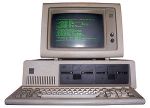
From 1974-1988, two improvements in computer technology marks the beginning of the fourth generation: the replacement of the memories with magnetic cores, for the silicon chip and the placement of many more components on a Chip: product micro-miniaturization of electronic circuits. The small size of microprocessor chips made possible the creation of personal computers (PC). Today
technologies LSI (large scale integration) and VLSI (very large scale integration) allow hundreds of thousands of electronic components are stored on a chip. Using VLSI, a manufacturer can make a small computer with a computer would rival the first generation that occupied an entire room. They made their big debut microcomputers.
technologies LSI (large scale integration) and VLSI (very large scale integration) allow hundreds of thousands of electronic components are stored on a chip. Using VLSI, a manufacturer can make a small computer with a computer would rival the first generation that occupied an entire room. They made their big debut microcomputers.
Microcomputers or Personal Computers (PCs) had its origin with the creation of microprocessors. A microprocessor is "a computer on a chip" that is an independent integrated circuit. The PC's are computers for personal use and are relatively inexpensive and are now in offices, schools and homes.
The PC term is derived from that by the year 1981, IBM, she released her model "IBM PC" , which became a kind of ideal computer for use "personal" hence the term "PC" clones were standardized and subsequently took other companies that were called "PC compatible" processors using the same type as the IBM, but at a lower cost and can run the same type of program. There are other types of microcomputers, such as the Macintosh, which are not compatible with IBM, but in many cases they are also called "PC's", being of use. Microprocessor The first microprocessor was the Intel 4004, produced in 1971. It was originally developed for a calculator, and it was revolutionary for its time. It contained 2,300 transistors in a 4-bit microprocessor that could perform only 60,000 operations per second. The first 8-bit microprocessor was the Intel 8008, developed in 1972 for use in computer terminals. The Intel 8008 contained 3,300 transistors. The first microprocessor actually designed for general use, developed in 1974, was the 8-bit Intel 8080, which contained 4,500 transistors and could execute 200,000 instructions per second. Modern microprocessors have a much greater speed and capacity.
These include the Intel Pentium Pro, with 5.5 million transistors, the UltraSparc-II, Sun Microsystems, which contains 5.4 million transistors, the PowerPC 620, developed jointly by Apple, IBM and Motorola, 7 million transistors, and the Alpha 21164A, Digital Equipment Corporation, with 9.3 million transistors. The microprocessor is an electronic circuit that acts as a central processing unit of a computer, providing control of the calculations.
microprocessors are also used in other advanced electronic systems, such as printers, automobiles and airplanes. In 1995 there were about 4,000 million chips worldwide. The microprocessor is a highly integrated circuit type. Integrated circuits, also known as microchips or chips, are complex electronic circuits consisting of extremely small components formed on a single thin, flat piece of semiconductor material known as
No comments:
Post a Comment